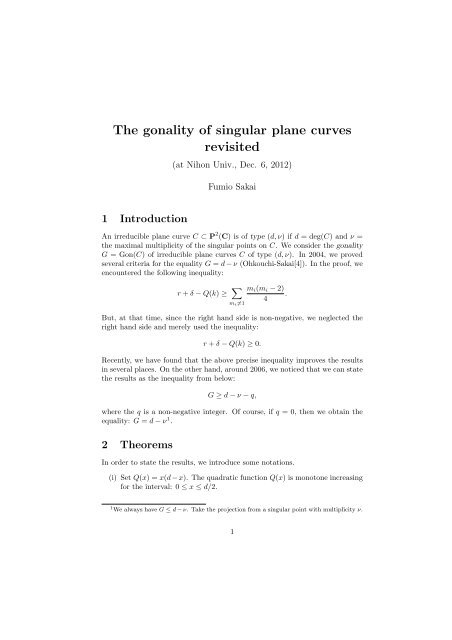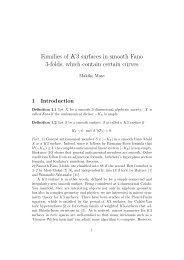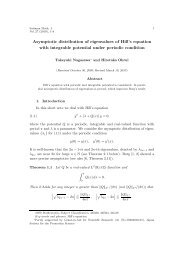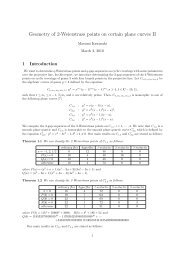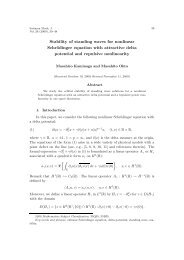The gonality of singular plane curves revisited
The gonality of singular plane curves revisited
The gonality of singular plane curves revisited
Create successful ePaper yourself
Turn your PDF publications into a flip-book with our unique Google optimized e-Paper software.
(ii) We denote by m 1 , . . . , m n the multiplicity sequence <strong>of</strong> all <strong>singular</strong> pointson C (the infinitely near points are also included). We write asData(C) = [m 1 , . . . , m n ].We simply write [3 α , 2 β ] for [3, . . . , 3, 2, . . . , 2]. We also need the invariants:} {{ } } {{ }α β• δ =• V =n∑i=1n∑i=1m i (m i − 1),2m i (m i − 2).4(iii) Let ν i denote the i-th largest multiplicity among {m i }.ν 1 = ν. For i > n, we write ν i = 1. We setIn particular,σ = ν 2ν + ν 3ν + ν 4ν .(iv) Let q be a non-negative integer satisfying the property:2 ≤ d − ν − q ≤ d − ν.(v) Define⎧⎨ max {[d/ν], 3}k 0 =⎩max {[d/ν], 2}if d/ν ≥ σ − q/ν,otherwise.<strong>The</strong>orem 1. Let C be a <strong>plane</strong> curve <strong>of</strong> type (d, ν) (d ≥ 6). Let q be as above.We have the inequality:G ≥ d − ν − qif the following two conditions are satisfied.(A) δ ≤ Q([d/2]) − (d − ν − q),(B) δ ≤ Q(k 0 ) − (d − ν − q) + V .Remark 1. We make some remarks.(1) In [4], we employed the following assumption, which is stronger than bothConditions (A) and (B) (for the case in which q = 0 and [d/ν] ≥ 2):(C)δ ≤ Q([d/ν]) − (d − ν).(2) In case ν = 2, since Condition (A)= Condition (B), we obtain the result:δ ≤ Q([d/2]) − (d − 2 − q) ⇒ G ≥ d − 2 − qIn particular, if q = 0, then we recover the criteria in Coppens-Kato [1].2
(3) Furthermore, if ν = 2, then the above estimate from below is best possible.For those <strong>curves</strong>k∏C k : y 2k+1 = (x − a i ) 2 ,we have d = 2k + 1, Data(C) = [2 k 2], δ = k 2 , Q([d/2]) = k(k + 1). We haveδ = Q([d/2])−(d−2−q) for q = k −1. By <strong>The</strong>orem 1, we conclude that G ≥ k.On the other hand, C k is birational to the curve y 2k+1 = ∏ ki=1 (x − a i) and wesee easily that G ≤ k. Hence, the equality G = k holds.(4) In view <strong>of</strong> the pro<strong>of</strong>, it seems that Condition (A) cannot be improved. <strong>The</strong>reremains some possibility to weaken Condition (B). If ν ≥ 6 and if k 0 = [d/ν],then Condition (B) implies Condition (A). For the curveC : y 30 =i=12∏24∏(x − a i ) 6 (x − b j ),i=1we have ν = 6 and k 0 = 6. So Condition (B) is satisfied for q = 0. We obtainG = 30. Note that Data(C) = [6 16 ], δ = 240 and V = 96.For the case in which ν = 3, we succeeded in excluding Condition (B).<strong>The</strong>orem 2. Let C be a <strong>plane</strong> curve <strong>of</strong> type (d, 3) (d ≥ 6). Let q be as above.We have the inequality:G ≥ d − 3 − qj=1if Condition (A) with ν = 3 in <strong>The</strong>orem 1 is satisfied.Remark 2. In case ν ≥ 5 and q = 0, Condition (A) alone does not give theresult G = d − ν. <strong>The</strong>re are counterexamples.For those cases in which ν = 2, 3, we state the results in terms <strong>of</strong> the genusg <strong>of</strong> the curve C.Proposition 1. Let C be a <strong>plane</strong> curve <strong>of</strong> type (d, 2) with d ≥ 6. If{(d + 1)(d − 3) 1/4 if d is even,g ≥ −40 if d is odd,then the equality: G = d − 2 holds.Proposition 2. Let C be a <strong>plane</strong> curve <strong>of</strong> type (d, 3) with d ≥ 6. If{(d + 2)(d − 4) 0 if d is even,g ≥ +41/4 if d is odd,then the equality: G = d − 3 holds.3
Remark 3. For ν = 2, the above result is best possible (Coppens-Kato[1]). Forν = 3, at least for d = 8, the result is best possible. For d = 8, we infer fromProposition 2 that if g ≥ 10, then G = 5. Now, the octic curveC : y(x 2 − 1) 3 (x − 2) − (y 2 − 1) 3 (y − 2) = 0has four ordinary triple points, hence Data(C) = [3 4 ]. Let φ be the rationalfunction on C induced by Φ = (x 2 − 1)/(y 2 − 1). We see that deg(φ) = 4.On the the hand, by <strong>The</strong>orem 2, we have G ≥ 4. We conclude therefore that(g, G) = (9, 4).3 Rational functionsLet C : F = 0 be a <strong>plane</strong> curve <strong>of</strong> type (d, ν). A rational function φ on C isinduced by a rational function Φ = G/H on the projective <strong>plane</strong> P 2 as φ = Φ |C ,where the G, H are relatively prime homogeneous polynomials having the samedegrees and F ̸ | H. Letting k = deg(G) = deg(H), we say that Φ is a rationalfunction <strong>of</strong> degree k on P 2 . <strong>The</strong> degree r = deg(φ) can be computed as follows.By successive blowing ups over P 2 , we simultaneously resolve the base points<strong>of</strong> the rational map Φ : P 2 → P 1 and the <strong>singular</strong> points <strong>of</strong> C. Let ˜Φ : X → P 1denote the resulting morphism.X s = X ⊃ ˜C↓.↓X 1↓X 0 = P 2 ⊃ C˜Φ↘Φ P 1For each i, let π i : X i → X i−1 be the blowing up at a point P i . Let m i denotethe multiplicity <strong>of</strong> C at P i . Note that m i ≥ 0. Let ˜C be the strict transform <strong>of</strong>C on X. <strong>The</strong>n the degree r is nothing but the intersection number <strong>of</strong> ˜C and afibre f <strong>of</strong> the map ˜Φ. By construction,˜C ∼ π ∗ O(d) −f ∼ π ∗ O(k) −s∑m i E i ,i=1s∑a i E ii=1(a i ’s are non-negative integers).where the E i is the total transform <strong>of</strong> the exceptional curve <strong>of</strong> π i .4
Lemma 1. We have the formulae:(i) k 2 =s∑a 2 i ,i=1(ii) r = dk −s∑a i m i .Proposition 3. We now come to the inequality stated in Introduction. Namely,we haver + δ − Q(k) ≥ V.Pro<strong>of</strong>. See [4].i=1Example 1. We examine the case in Remark 3.C : y(x 2 − 1) 3 (x − 2) − (y 2 − 1) 3 (y − 2) = 0Φ = x2 − 1y 2 − 1 , φ = Φ |CWe blow up 4 points P 1 = (1, 1), P 2 = (−1, 1), P 3 = (−1, −1), P 4 = (1, −1). Wehave a i = 1, m i = 3 for i = 1, . . . , 4. Thus we see that r = 8 · 2 − (1 · 3) × 4 = 4.˜CfE 1E 2E 3E 4˜ΦP 1Proposition 4. If r < d − ν − q, then we have k ≥ k 0 .Pro<strong>of</strong>. Suppose r < d − ν − q. It is easy to show that k ≥ 2. In case k = 2, wemust have d/ν < σ − q/ν (Cf., [4]). Now we prove the inequality: k ≥ [d/ν].By Lemma 1 (ii), we infer that r ≥ dk − ( ∑ a i )ν. Since ∑ a i ≤ ∑ a 2 i = k2 ,we see that r ≥ k(d − kν). By using the assumption r < d − ν, we have(k 2 − 1)ν > (k − 1)d, from which follows that k + 1 > d/ν. Hence we havek ≥ [d/ν].5
4 Pro<strong>of</strong>sPro<strong>of</strong> <strong>of</strong> <strong>The</strong>orem 1. (1) Assume to the contrary that G < d − ν − q. <strong>The</strong>reexists a rational function φ on C such that r = deg(φ) < d − ν − q.(2) According to the following key Lemma, if Condition (A) is satisfied, then,we can find a rational function Φ on P 2 with degree k = deg(Φ) < [d/2], whichinduces φ.Lemma 2 ([4, 5]cf., [1, 2]). Let φ be a rational function on a <strong>plane</strong> curve C<strong>of</strong> degree d. Set r = deg(φ). If there is a positive integer l < d, which satisfiesthe inequality:r + δ < Q(l + 1),then there exists a rational function Φ on P 2 with k = deg(Φ) ≤ l, which inducesφ.Indeed, under Condition (A), we have the inequality:r + δ < Q([d/2]).<strong>The</strong>refore by letting l = [d/2] − 1 in Lemma 2, we can find a rational functionΦ on P 2 with degree k = deg(Φ) < [d/2], which induces φ.(3) By Proposition 4, we have k ≥ k 0 . Since k 0 ≤ k < [d/2], we haveQ(k 0 ) ≤ Q(k). By Proposition 3, we haveWe then obtain the inequality:which contradicts Condition (B).r + δ ≥ Q(k) + V.δ > Q(k 0 ) − (d − ν − q) + V,Pro<strong>of</strong> <strong>of</strong> <strong>The</strong>orem 2. In case ν = 3, we can write Data(C) = [3 α , 2 β ]. In asimilar manner to that in the pro<strong>of</strong> <strong>of</strong> <strong>The</strong>orem 1, we may assume the existence<strong>of</strong> a rational function φ on C <strong>of</strong> r = deg(φ) < d − 3 − q, and a rational functionΦ on P 2 with k = deg(Φ) < [d/2], which induces φ.Lemma 3. For ν = 3, we have the following bound:∑ai m i ≤ 2k 2 + α.Pro<strong>of</strong>. We argue as follows:∑ ∑k 2ai m i ≤ ν i ≤ 2k 2 + α.i=16
We first prove the second inequality. We have three subcases: (a) α + β ≤ k 2 ,(b) α < k 2 ≤ α + β, (c) k 2 < α.⎧∑k 2⎨ 3α + 2β + (k 2 − α − β) = k 2 + 2α + β ≤ 2k 2 + α for (a)ν i ≤ 3α + 2(k 2 − α) = 2k 2 + αfor (b)⎩i=1 3k 2 < 2k 2 + αfor (c)To check the first inequality, we may assume that a 1 ≥ . . . ≥ a b ≥ 1 and a j =0 for j > b. Note that b ≤ k 2 and ∑ a i m i ≤ ∑ a i ν i . For the sake <strong>of</strong> simplicity,we restrict ourselves to the case in which (1)α + β ≤ b. In this case, we have∑ν i −k 2i=1b∑a i ν i = 3α + 2β + (k 2 − α − β) −i=1=⎛b∑α∑a 2 i + 2α + β − ⎝3 a i + 2i=1=i=1α∑(a i − 1)(a i − 2) +i=1α+β∑i=α+1b∑a i ν i ,i=1α+β∑i=α+1a i +(a i − 1) 2 +b∑i=α+β+1b∑i=α+β+1a i⎞⎠ ,a i (a i − 1) ≥ 0.We can similarly deal with the other subcases (2) α ≤ b < α + β, (3) b < α ≤α + β, (4) α ≤ b, (5) b < α. .Using this inequality, by Lemma 1, (ii), we haveOr equivalently, we haved − 3 − q > dk − (2k 2 + α).2(k 2 − 1) > d(k − 1) − (α − 1 − q).By dividing by k − 1 (Note that k ≥ 2), we obtaink > d 2 − α − 1 − q2(k − 1) − 1.Since k < [d/2], we must have α − 1 − q > 0. Using k ≥ [d/3], we obtaink > d (2 − λ − 1 λ =α − 1 − q ).2([d/3] − 1)Lettingk 1 =[ d2 − λ ],we have the inequality: k ≥ k 1 .Lemma 4. We have the inequality: V ≥ Q([d/2]) − Q(k 1 ).7
Now, we complete the pro<strong>of</strong> <strong>of</strong> <strong>The</strong>orem 2. By Proposition 3, we haveHence, we haveBy Lemma 4, we then havewhich contradicts Condition (A).Pro<strong>of</strong> <strong>of</strong> Lemma 4. Setr + δ ≥ Q(k) + V ≥ Q(k 1 ) + V.δ > Q(k 1 ) + V − (d − 3 − q).δ > Q([d/2]) − (d − 3 − q),J = V − {Q([d/2]) − Q(k 1 )} .We have to prove that J ≥ 0. By definition, V = (3α)/4.Here, we only consider the case in which d is even and λ ∉ N. See [5], fordetails. We have k 1 = [d/2] − t, where t = [λ] + 1. We see thatQ([d/2]) − Q(k 1 ) = t 2 .Since k 1 < [d/2], we must have t ≥ 1. Hence, we have λ > 0. Since δ = 3α + β,Condition (A) gives the inequality:3α ≤ (d − 2) 2 /4 + 2 + q. (1)Noting that [d/3] ≥ (d − 2)/3, the definition <strong>of</strong> λ gives the inequality:3α ≥ 2λ(d − 5) + 3(1 + q). (2)Step 1. Combining (1), (2), we havewhich gives the inequality:d ≥ 8λ − 1 + 8q − 5d − 5 ,d ≥ 8λ − 7/2 (unless t = 1). (3)Indeed, the above inequality holds except if d = 6 and q = 0. If d = 6, q = 0,then by (1), we have α ≤ 2, hence λ = 1/2. So t = 1.Step 2. Using (2), (3), we haveJ ≥3(12 + q)4(+ 3t t − 49 ).12Consequently, we have J ≥ 0 if t ≥ 3 unless t = 3, q = 0.8
Step 3. We check the cases in which t ≤ 3. Assume to the contrary that J < 0(or, equivalently, 3α/4 < t 2 ). We have to consider the following three cases:(i) t = 1, α = 1, (ii) t = 2, α ≤ 5, (iii) t = 3, q = 0, α ≤ 11.(i) We have λ = 0. This is not the subcase which we consider. (ii) By thedefinition <strong>of</strong> λ, we have α = 5, d = 6, 8, q ≤ 1, or α = 4, d = 6, q = 0. But, by(1), if d = 8, q ≤ 1, then we have α ≤ 4. If d = 6, q ≤ 1, then we have α ≤ 2.So we arrived at a contradiction. (iii) By (2), we have 10 ≤ α ≤ 11, d ≤ 10, or6 ≤ α ≤ 9, d ≦ 8. By (1) again, if d = 10, q = 0, then α ≤ 6 and if d ≤ 8, q = 0,then α ≤ 2. We arrived at a contradiction.References[1] M.Coppens and T.Kato, <strong>The</strong> <strong>gonality</strong> <strong>of</strong> smooth <strong>curves</strong> with <strong>plane</strong> models,Manuscripta Math. 70, 5–25 (1990).[2] M.Coppens and T.Kato, Correction to the <strong>gonality</strong> <strong>of</strong> smooth <strong>curves</strong> with<strong>plane</strong> models, Manuscripta Math. 71, 337–338 (1991).[3] M.Namba, Families <strong>of</strong> meromorphic functions on compact Riemann surfaces,Lecture Notes in Math. 767, Springer-Verlag, 1979.[4] M.Ohkouchi and F.Sakai, <strong>The</strong> <strong>gonality</strong> <strong>of</strong> <strong>singular</strong> <strong>plane</strong> <strong>curves</strong>, Tokyo J.Math. 27, 137 – 147 (2004).[5] F.Sakai, <strong>The</strong> <strong>gonality</strong> <strong>of</strong> <strong>singular</strong> <strong>plane</strong> <strong>curves</strong> II, To appear in Proceedings<strong>of</strong> the Conference on Affine Algebraic Geometry in Osaka, March, 2011.Fumio SAKAIDepartment <strong>of</strong> MathematicsGraduate School <strong>of</strong> Science and EngineeringSaitama UniversityShimo–Okubo 255Sakura–ku, Saitama 338–8570, JapanE–mail: fsakai@rimath.saitama-u.ac.jp9


